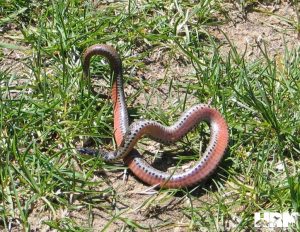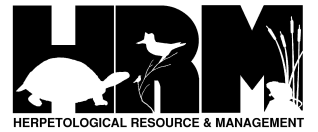Kirtland’s Snake
Overview:
Scientific Name: Clonophis kirtlandii
Size: 14 – 24.5” (adult total length)
Status: Rare and declining throughout range.
Michigan State Status: Endangered;
MDNR Wildlife Action Plan Status: Species of Greatest Conservation Need

Habitat:
Prefer moist habitats, usually near streams, ditches, marshes, or ponds. Most often found in grassy areas such as wet prairies, wet meadows, fens, swales, and pastures. Also may occupy swampy forests.
Adult Coloration:
Reddish to grayish brown background with four rows of alternating dark, rounded blotches down the back and sides. These marks are often faded in very young and old adults. Sometimes with faint stripe down the center of the back. Head black or brown, sometimes with light mottled pattern. Labial scales (along the mouth) and chin and throat white, cream, or yellow. Belly pink, red, or orange with black spots in rows on each side. Occasionally irregular dark spotting between rows of spots on belly.
Adult Characteristics:
Small narrow headed snake with keeled scales and a divided anal plate.
Juvenile Characteristics:
Newborns range from 4.3 – 6.6” in length, and are darker than adults, sometimes with a faint blotched pattern. Belly is deep red.
Scale Count:
17-19 scale rows at midbody
Species Confused With:
Garter Snakes can be distinguished by their dorsal stripes, solid pale bellies, and undivided anal plate. Red-bellied Snakes are smaller and do not have dorsal blotches or rows of belly spots. Copper-bellied Water Snakes are bigger and also lack rows of spots on the belly.
References:
- Amphibians and Reptiles of the Great Lakes Region by Jim Harding
- Harding, J.H. and J.A. Holman. 2006. Michigan Snakes. MSU Extension Ext. Bulletin E-2000,74 pp. [revised].
- Ruthven, A. G., H. B. T. Gaige, et al. 1912. The herpetology of Michigan, by Alexander B. Ruthven. Crystal Thompson and Helen Thompson; Memoranda towards a bibliography of the archaeology of Michigan, by Harlan I. Smith; prepared under the direction of Alexander G. Ruthven. Lansing, Mich., Wynkoop Hallenbeck Crawford, State Printers.
- Holman, J. A. 2012. The Amphibians and Reptiles of Michigan: A Quaternary and Recent Faunal Adventure. Detroit, Mich., Wayne State University Press.
- Conant, R., and Collins, J. T. 1998. Reptiles and Amphibians: Eastern, Central North America. Houghton Mifflin Harcourt Press.
